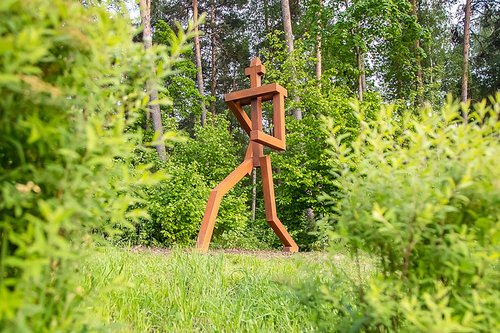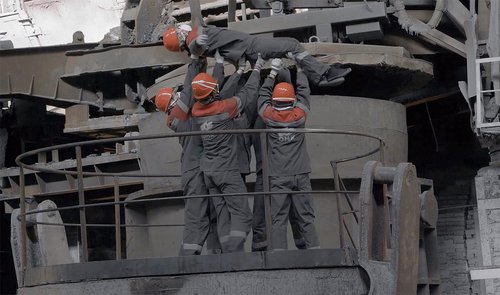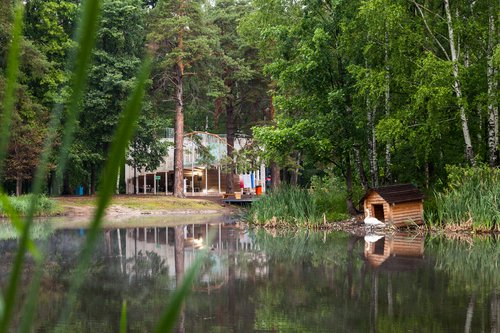Public art project 'To Be Here'. Moscow, 2024. Courtesy of the PR service of 'To Be Here' project
How Resilient is Nature Asks ‘To Be Here’
An exhibition on the outskirts of Moscow looks at nature's quiet reclamation of abandoned spaces and the relentless spread of human urbanization. Through immersive installations, artists explore environmental balance, highlighting the delicate interplay between human development and the natural world.
On my way to the exhibition ‘To Be Here’ on the outskirts of Moscow, I reflected on how animals began to appear in the middle of our cities during the pandemic when people left the urban streets. We saw (and with the epidemic itself) how nature tolerates us but as soon as it has the slightest chance to take back what us humans have taken away from it, it seizes the moment. Nature settles quickly in abandoned buildings. Trees start to grow on the roof, cats and mice breed inside; even homeless people sleeping there seem to somehow merge with nature and its conditions.
Curator Vera Ershova had the idea behind the site-specific project ‘To Be Here’ a year ago when driving past the mothballed building of a future cultural centre next to the gated community where she lives. With its grey concrete walls, raw windows and doorways and a forest out the back, the space seemed perfect for a summer exhibition and close by is the Gorki Leninskiye Museum, a cultural development with a park and good transport links to the centre of Moscow.
The project ‘To Be Here’ addresses environmental issues head-on by a crop of young Russian art students and graduates. Existing in the ‘here and now’ is a phrase repeated in many of the arists’ comments when talking about their work, also the name of one of the most imposing works in the show, a land-art object by Sveta Metso (b. 1988) with light and sound effects. There are real issuses in this specific geography outside the capital city as the Moscow region is now being built upon and many parts of the landscape are disappearing. Close to Gorki Leninskiye there is a linden forest and the source of the river Turovka which has endangered species of plants, birds as well as ancient archaeological sites. In the exhibition artist Oksana Vinogradova reflects this in her installation ‘The Way of the River’.
Curators Vera Ershova and PollyT are currently studying at the Joseph Backstein Institute of Contemporary Art (ICA, formerly IPSI), and they invited its current students and graduates to come up with works on the theme of the interaction between urban and natural environments and the local ecosystem. Over forty works created specially for the project by twenty-nine artists are displayed across three sites, in the unfinished building of the cultural centre, in the forest and in the park around the Gorki Leninskiye Museum. Art historian and curator Viktor Misiano and artists Dmitry Gutov (b. 1960) and Stas Shuripa (b. 1971) who is also a rector of ICA acted as advisors on the project.
One theme common to many of the works that of the myriad of microorganisms that inhabit our planet as well are our lives. In ‘Air Perspectives: Mutualism’ artist Yulia Parfenova makes sculptures depicting phytoplankton enlarged hundredfold, "the main producer of oxygen on the planet" and places them around the exhibition disguised as architectural details. In ‘We Are Connected’ Angelina Ushko (b. 1998) weaves a net depicting boundary organisms, "Wherever we go, everywhere we are surrounded by fungi and mould, everything belongs to them. It is their world."
The global issue of the overuse of plastics is another subject the show addresses. Lisa Alexeeva's installation ‘Lethargy’ is in the forest, large balls made from plastic bags, a symbol of consumption, which threatens both nature and human life. Natalia and Denis Lotarev’s ‘Polymerides’ offer a dream, asking what if nature, which can take back what is unnecessary to humans, could learn to recycle plastic? And thanks to this polymer metabolism, would new forms of flora appear on the walls and ceiling of an abandoned building?
The forest behind the building proves to be rich fodder for the imagination, with many artists tapping into their childhood memories of the forest as something mystical, mysterious, and unknown. Sveta Metso humanises her ‘Forest Spirits’ by adding multicoloured heads to tree stumps. In ‘Dwelling’ Danil Danot (b. 1993) constructed a real tent and on a tree next to it he planted his work ‘Lodger’, a creature sewn from fabric, reminiscent of a monster from a fairy tale. Lubov Remizova's (b. 1983) mermaids ‘The Lost Bride’ personify "the silent cry that wants to be heard", perhaps the cry of nature tortured by humans.
Nature continues to resist - when passing through the doorways of an unfinished building, visitors can scratch themselves on the huge ceramic spikes that form unusual arches in Olga Bozhko's (b. 1974) installation ‘Through the Abyss’. A play on words and the search for new visual meanings is a constant theme in the artist's work, here she encourages us to pass through the terrible mouth of a mystical animal with green teeth yet warns us that there may be an abyss ahead and we may lose our way. Artists try to negotiate with nature by mimicking it, like Anna Salimzyanova who painted the surface of a conventional park scupture ‘Girl with Grapes’, to imitate the texture of tree bark, or Polina Krutova (b. 1985) who planted a wooden chair among trees in ‘One Hundred Years of Solitude’ or Sveta Kalashnikova in ‘Adaptation VI. Birch World’ whose birch trees are dressed up in clothes made of felt
In this continuing dialogue between art and nature throughout the exhibition there is a body of works made of grass. In her work ‘Imprint’ Oksana Vinogradova places branches and dry grass in a concrete cube, decorating it with prints of leaves on metal and in ‘Translatability’ Anastasia Myachina makes paper from grass. ‘Samsara’ which means the cycle of birth and death, the title of Raisa Volkova and Anna Zaikovskaya’s woven tapestry of field herbs which gives them new life, but she also divides it with a red thread which representing the cardiogram of a clinically dead person. ‘Heat Exchange’ by Anna Salimzyanova is a huge straw ball floating in a semi-dark room, which represents the sun, literally hugged by a knitted jumper the artist has creating an allegory of the presevation of heat and energy and the work exudes a sense of rarely felt optimism amonst the gloomy predictions.
‘To Be Here’ is otherwise short on positivity, an angst-ridden show despite its meditative nature with chairs set out for visitors to admire the forest and the opportunity to take part in breathing and contemplation sessions in the forest. The general tenor is perhaps summed up best in two works dominated by blackness. ‘The Well’ is an interactive sculpture by artist and curator Vera Ershova made from black fabric which forms a tunnel at the end of which visitors become completely disorientated in total darkness, perhaps gaining the ability to look into another reality and rethink the present. Another work made from black fabric is Pavel Zudanov's (b. 1991) monumental inflatable installation ‘Dark Structures’ which ominously fills the hall of the main building.
Public art project 'To Be Here'
Yuzhnaya Dolina Residential Complex and Gorki Leninskie Museum-Reserve
Moscow region, Russia
11 August – 15 September 2024



















